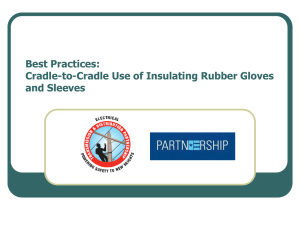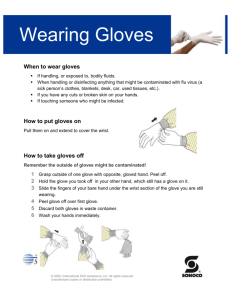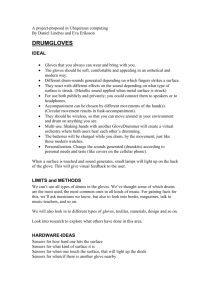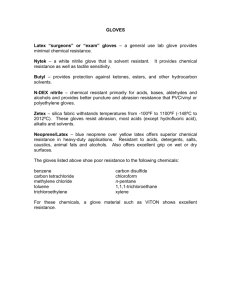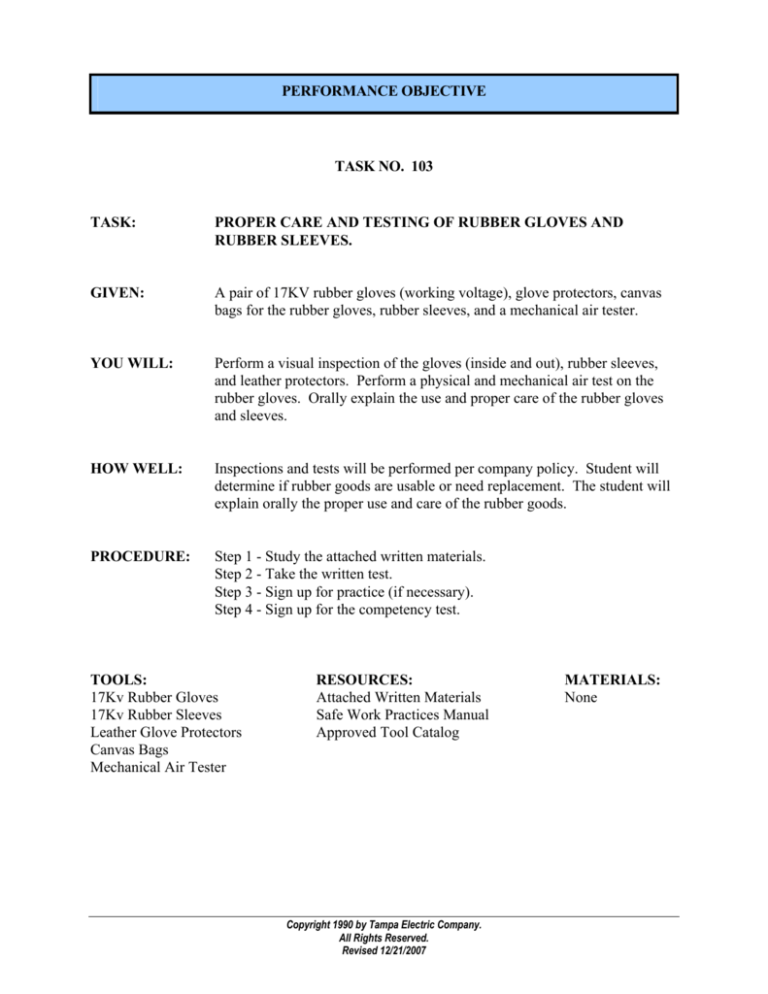
PERFORMANCE OBJECTIVE
TASK NO. 103
TASK:
PROPER CARE AND TESTING OF RUBBER GLOVES AND
RUBBER SLEEVES.
GIVEN:
A pair of 17KV rubber gloves (working voltage), glove protectors, canvas
bags for the rubber gloves, rubber sleeves, and a mechanical air tester.
YOU WILL:
Perform a visual inspection of the gloves (inside and out), rubber sleeves,
and leather protectors. Perform a physical and mechanical air test on the
rubber gloves. Orally explain the use and proper care of the rubber gloves
and sleeves.
HOW WELL:
Inspections and tests will be performed per company policy. Student will
determine if rubber goods are usable or need replacement. The student will
explain orally the proper use and care of the rubber goods.
PROCEDURE:
Step 1 - Study the attached written materials.
Step 2 - Take the written test.
Step 3 - Sign up for practice (if necessary).
Step 4 - Sign up for the competency test.
TOOLS:
17Kv Rubber Gloves
17Kv Rubber Sleeves
Leather Glove Protectors
Canvas Bags
Mechanical Air Tester
RESOURCES:
Attached Written Materials
Safe Work Practices Manual
Approved Tool Catalog
Copyright 1990 by Tampa Electric Company.
All Rights Reserved.
Revised 12/21/2007
MATERIALS:
None
INSULATING RUBBER GLOVES AND RUBBER SLEEVES
The following rules regarding insulated rubber gloves and sleeves are for the safety of those
working on or near energized lines and/or equipment.
1.
Rubber gloves shall be worn when working on exposed energized lines or equipment that
is energized at 50 volts or more.
2.
Rubber gloves shall be worn when working on ungrounded lines and equipment that are
subject to backfeed and induced voltage.
3.
In addition to rubber gloves, rubber sleeves shall also be worn if exposed energized parts
on which work is not being performed are not insulated from the employee, exposing the
employee’s upper arm to contact with other energized parts.
4.
The maximum voltage for which rubber gloves alone shall be used is 5,000 volts to
ground. Any voltage in excess of this shall be worked by an approved method only.
5.
Rubber gloves shall not be worn without leather protectors.
6.
Before work requiring rubber gloves begins each day, each glove shall be visually
inspected and air tested by the employee using the gloves. Defective gloves shall not be
used.
7.
Where rubber sleeves are required, each sleeve shall be visually inspected daily.
Defective sleeves shall not be used.
8.
Rubber gloves shall be tested electrically every 60 days or more often if field conditions
warrant. Annually, rubber sleeves shall be tested electrically or more often if field
conditions warrant.
9.
Rubber gloves and sleeves shall be stored in approved bags in a fully extended position.
Rubber gloves and sleeves shall not be folded. Bags shall be either hung up or placed in
a special compartment. They shall not be placed where other tools or equipment can
damage the rubber gloves or sleeves.
10.
Two pairs of rubber gloves, one inside the other, shall not be worn.
11.
Care shall be taken to prevent gloves and/or sleeves from coming into contact with oilbased products.
12.
No items are permitted to be placed in the rubber glove bag (or sleeves bag) along with
the rubber gloves and protector gloves (or sleeves).
13.
Protectors shall not be worn in place of work gloves.
Module 103 – Proper Care and Testing of Rubber Gloves and Rubber Sleeves
Page 1
14.
After use, rubber gloves should be washed daily at the end of the shift prior to storage.
VOLTAGE RATINGS
Rubber gloves are rated at five different voltage classes:
Class
Manufacturers’
Working Voltage
Tampa Electric Company’s
Working Voltage
0
1,000 Volts
600 Volts
1
7,500 Volts
2
17,000 Volts
3
25,500 Volts
30,000 Volts
4
36,000 Volts
40,000 Volts
Testing Voltage
5,000 Volts
10,000 Volts
17,000 Volts
20,000 Volts
ISSUED GLOVES
Tampa Electric Company purchases two types of
rubber gloves: Class 0 and Class 2. All operating
personnel are issued two pairs of rubber gloves.
Rubber sleeves are issued to Operations Center
personnel. The rubber gloves working voltage is
7,000 volts.
When the gloves are issued to you, an identifying
number is placed on them. At that time, you will
become completely responsible for the care and
testing of your rubber gloves before work begins
each day.
THE GLOVES ARE YOUR
NUMBER ONE PROTECTION
AGAINST ELECTRICAL SHOCK.
Rubber gloves are tested at 20,000 volts and are rotated every 60 days for electrical testing by
the Meter Department. This means that you will always have one pair in your possession for
work use. The other pair will be at the Meter Department for testing purposes.
Tampa Electric Company purchases 18-inch rubber gloves with a curved hand. The working
voltage of these rubber gloves is 17,000 volts. Rubber gloves are available in different hand
sizes ranging from size 9 to size 12 in ½ size increments. The size glove required by an
individual is a matter of personal preference, determined by trying them on.
Module 103 – Proper Care and Testing of Rubber Gloves and Rubber Sleeves
Page 2
RUBBER GLOVE PROTECTORS
Rubber glove protectors are leather gloves with a long cuff that are worn over the rubber gloves
to help protect them from punctures, cuts, and scratches. The cuff of the protective glove is
colored with a fluorescent material to make them easily identifiable for both the user and the
observer of work being done in a primary area. PROTECTIVE GLOVES SHALL NOT BE USED
AS A SUBSTITUTE FOR CANVAS GLOVES OR WORK GLOVES. Protective gloves shall be
checked visually on a periodic basis to make sure they have no rips or tears.
RUBBER GLOVE PROTECTORS
Module 103 – Proper Care and Testing of Rubber Gloves and Rubber Sleeves
Page 3
CARE AND STORAGE OF RUBBER GLOVES
These rules are very important as negligence in
observing them will result in glove failure:
y
Rubber gloves must always be stored in
a canvas glove bag made especially for
that purpose.
y
When the rubber gloves are placed into
the canvas glove bag, the gauntlet end
(the open end) of the glove shall be entered
first.
y
RUBBER GLOVES SHALL NEVER BE
FOLDED FOR STORING.
y
TOOLS AND EQUIPMENT SHALL NEVER
BE PLACED ON TOP OF THEM.
y
Rubber gloves shall never be stored where
they are subjected to direct sunlight.
y
There is a special bin on the company’s
line trucks for rubber glove storage. This
site is to be used when they are not stored
on your belt.
CANVAS GLOVE BAG FOR
RUBBER GLOVES
Module 103 – Proper Care and Testing of Rubber Gloves and Rubber Sleeves
Page 4
FIELD INSPECTION, TESTING, AND CARE
Rubber gloves must always be field inspected AND tested prior to using them. Rubber gloves
are field-tested using air inflation. Air inflation can be accomplished via either mechanical air
inflation or, what is referred to as, physical air inflation.
PHYSICAL AIR INFLATION
To physically air test a rubber glove:
1.
Remove the leather protector.
2.
Grasp the cuff of the rubber glove on each side and stretch the cuff until it lays flat with
opposite edges touching each other.
3.
While holding the cuff in this position, twirl the glove around its cuff. This maneuver will
trap air inside the glove inflating its hand and finger areas. The more the glove is twirled,
the higher the hand and finger areas will be inflated.
4.
Grasp the rolled cuff tightly, so as not to let any air escape in one hand and hold the glove
so that its hand and finger areas can be placed close to your ear. Any air escaping from the
glove will make a hissing noise, which would indicate that the glove is defective. Because
the fingers and the area of the palm between the thumb and forefinger receive the most
abuse, they should be checked with utmost care.
If there is any
doubt as to the
glove’s integrity,
DO NOT USE IT!
Module 103 – Proper Care and Testing of Rubber Gloves and Rubber Sleeves
Page 5
MECHANICAL AIR INFLATION
Portable glove inflators are available to mechanically inflate rubber gloves for testing. This
testing procedure is much more thorough than the physical air inflation method for two reasons.
First, with the physical air inflation method, the sound of escaping air is your primary indication
of glove failure. The higher volume of air created inside the glove by the mechanical air inflator
allows you to visually check for defects that might not allow an escape of air. (These types of
defects will be explained later in this module.) The second reason mechanical air inflation is
more thorough is because the cuff does not have to be rolled up; it too can be examined for
defects.
PORTABLE GLOVE INFLATOR
Module 103 – Proper Care and Testing of Rubber Gloves and Rubber Sleeves
Page 6
OPERATING INSTRUCTIONS
Follow the instructions below to operate a portable glove inflator:
1.
Seat the bead of the glove’s cuff in the first groove of the portable inflator. This can be
accomplished by seating as much of the bead as possible without stretching it, then holding
that part of the bead in place with your thumb and finger.
2.
Use your other hand to pull the remaining glove bead over the bell of the inflator, and
seating it in the first groove. Check the bead of the glove is seated in the groove evenly by
pulling out on the bead and letting it snap into place.
Module 103 – Proper Care and Testing of Rubber Gloves and Rubber Sleeves
Page 7
3.
Roll the inflator’s O ring up over the bead of the glove to lock the glove to the bell.
4.
With the heels of your hands pressing the glove cuff against the top of the bell, place your
fingers under the bell in the first convolution of bellows and hold firmly.
Module 103 – Proper Care and Testing of Rubber Gloves and Rubber Sleeves
Page 8
5.
With a stiff arm motion, pump the bellows approximately six to eight times against a hard
surface. Tilt the inflator slightly to release suction between pumps.
6.
Once the glove is fully inflated, the glove should be inspected for damage and leakage.
(See the next section, “WHAT TO LOOK FOR WHILE THE GLOVE IS INFLATED.”)
7.
To release the glove from the inflater, hold a finger of the glove with one hand and the
inflater with the other. Roll the O ring back off of the glove’s bead with your forefinger.
Air pressure inside the glove will cause it to pop off of the inflator.
Module 103 – Proper Care and Testing of Rubber Gloves and Rubber Sleeves
Page 9
8.
Turn the glove inside out and follow the same procedures to inspect the inside of a glove.
BE ABSOLUTELY CERTAIN to turn the glove right side out after inspection.
Note: The gauntlet diameter and shape of some gloves will vary from
manufacturer to manufacturer. If the gauntlet is large, as is normally the
case for rubber gloves with the red colored interior, it will go over the bell
end of the mechanical tester quite easily and Steps 1, 2 and 3 will be slightly
different to obtain an adequate air seal. When this occurs, roll the O ring
up to the top of the metal band on the bell. Pull the glove bead over the bell
to the metal portion, then roll the O ring back over the glove, and continue
with Steps 5, 6, 7 and 8.
WHAT TO LOOK FOR WHILE THE GLOVE IS INFLATED
Now that you have been introduced to the proper steps for performing a mechanical air test, you
need to know what to look for while the glove is inflated. Tampa Electric Company purchases
rubber gloves that have a black exterior and either a red or yellow interior. This is illustrated in
the figure below:
OUTER SURFACE IS BLACK
DEEP CUTS
SHOW A
CONTRAST IN
COLOR
INSIDE SURFACE IS YELLOW
Cross Section of Glove Wall
Module 103 – Proper Care and Testing of Rubber Gloves and Rubber Sleeves
Page 10
The dual coloring provides an easy means to detect any glove
defects. If the red or yellow coloring shows through the black
exterior while the glove is inflated, the glove is defective and
shall not be used.
Rubber gloves should be washed on a daily basis or when
they become dirty on the inside. They should be turned
inside out and washed with a mild soap and water. They
must be thoroughly dried and turned right side out before
they are stored. It was emphasized, earlier in this module,
the importance of storing the rubber gloves properly.
When gloves are not used and stored improperly,
corona damage can occur.
CORONA DAMAGE
The rubber used for rubber gloves and rubber sleeves is made from the sap of the rubber tree.
This means the rubber is of vegetable origin. Like any other product of vegetable origin, it is
subject to oxidation and deterioration, which we commonly refer to as “rotting.” Certain factors
can speed up this rotting process. Corona is one of them.
Corona is produced anytime an electric arc occurs. Corona is the luminous discharge you see in
an electrical arc. This discharge results from the ionization of the air in the vicinity of the arc.
When air is ionized, a gas called ozone is produced. This ozone gas greatly accelerates the
rotting process of rubber and is referred to as ozone cutting or “corona damage.” Additionally,
corona damage is accelerated if the rubber is in a strain, such as it would be if it were folded.
With these factors in mind, and remembering that heat is also a natural enemy of rubber, it
should be easy to see why it is important that rubber gloves and sleeves be stored properly.
Again, they should be placed in their canvas bag in such a manner so as not to produce any
creases or folds. The bag should be stored in a cool, dry place away from any electrical
switchgear and protected from direct sunlight.
If your rubber gloves or sleeves show any defects or are suspicious, DO NOT USE
THEM. Make arrangements to have them immediately exchanged for your second pair.
Module 103 – Proper Care and Testing of Rubber Gloves and Rubber Sleeves
Page 11
RUBBER SLEEVES
Rubber sleeves shall be worn by the employee if the employee’s upper arm is exposed to noninsulated energized components on which no work is being performed.
Rubber sleeves are available in sizes regular, large,
and extra large. They have a flexible curved arm
to provide a more comfortable and natural fit. The
rubber sleeves are black on the outside and either
red or yellow on the inside. Like the rubber gloves,
this design is to help determine if the sleeves are
flawed. The rubber sleeves, like rubber gloves,
shall be visually inspected each day prior to use.
IF THE RED OR YELLOW COLOR CAN BE
DETECTED THROUGH THE OUTSIDE BLACK,
THE SLEEVES ARE DEFECTIVE AND SHALL
NOT BE USED.
RUBBER SLEEVE ACCESSORIES
Two rubber straps are used to connect the rubber sleeves. The straps keep the sleeves in place
while they are worn. Special two-piece fasteners are used to attach the straps to the sleeves. The
straps have several attachment holes so they can be adjusted to the size needed by the wearer.
Once the straps are in place, the sleeves are put on like a shirt with the two straps going across
the wearer’s back.
Module 103 – Proper Care and Testing of Rubber Gloves and Rubber Sleeves
Page 12
CANVAS SLEEVE BAG
The canvas sleeve bag is made for the specific
purpose of storing rubber sleeves. It must be
hung (stored) in an upright position when holding
the sleeves. When rubber sleeves are placed
into a sleeve bag, they shall be inserted forearm
end first. This will allow any moisture or water
to drain from the sleeves when the bag is stored.
Special care must be used when placing the
sleeves in the bag to make sure they do not fold
or crease. Folds and creases can cause corona
damage to the sleeves. A special bin is provided
on the company trucks for the storage of the sleeve
bags and sleeves. Under no circumstances shall
the sleeve bags and sleeves be stored lying flat
where something could be laid on top of them,
possibly creasing the sleeves.
The canvas bag must be hung
(stored) in an upright position
when holding the sleeves.
Module 103 – Proper Care and Testing of Rubber Gloves and Rubber Sleeves
Page 13
TEST
1.
2.
3.
Rubber gloves and rubber sleeves are:
A.
Optional in hot weather.
B.
Optional for voltages up to 600 volts.
C.
Your number one protection against electrical shock.
Rubber gloves and sleeves issued to line department personnel are voltage-rated at:
A
7,000 volts.
B.
17,000 volts.
C.
27,000 volts.
What must be worn over rubber gloves to protect them from punctures, cuts, and
scratches?
4.
5.
A.
Canvas work gloves.
B.
Leather gloves.
C.
Grab-it gloves.
When stored in their canvas glove bag, the rubber gloves will be:
A.
Placed in the bag folded, fingers first.
B.
Placed in the bag folded, gauntlet first.
C.
Placed in the bag unfolded, gauntlet first.
D.
Placed in the bag unfolded, fingers first.
Improperly stored rubber gloves and sleeves are subject to:
A.
Deterioration.
B.
Corona damage.
C.
Oxidation.
D.
All of the above.
TEST - Module 103
Page 1
6.
7.
8.
9.
10.
Rubber gloves are tested in three ways. One of these tests is performed by the Meter
Department. The other two are performed by the employee to whom they are issued.
The three tests are:
A.
_________________
B.
_________________
C.
_________________
Rubber gloves and sleeves purchased by our company are black on the outside and:
A.
Red or yellow on the inside.
B.
Red or white on the inside.
C.
Yellow or white on the inside.
D.
All of the above.
Rubber gloves are tested electrically every __________ or more often if field
conditions warrant it.
A.
30 days.
B.
60 days.
C.
90 days.
D.
6 months.
_______________ shall not be used as a substitute for work gloves.
A.
Rubber gloves.
B.
Glove protectors.
C.
Canvas gloves.
Care shall be taken to allow rubber gloves and sleeves to come in contact with oil-based
products.
11.
A.
True.
B.
False.
Rubber sleeves will be tested electrically ___________________ or more often if field
TEST - Module 103
Page 2
conditions warrant it.
A.
Once a year.
B.
Every 60 days.
C.
Every 6 months.
D.
Every 90 days.
TEST - Module 103
Page 3
ANSWER SHEET
1.
C
2.
B
3.
B
4.
C
5.
D
6.
Electrical testing
Mechanical air testing
Physical air testing
7.
A
8.
B
9.
B
10. B or False
11. A
ANSWER SHEET – Module 103
Page 1
FIELD EVALUATION
The competency test for rubber gloves and rubber sleeves is performed in the training shop.
There are several pairs of rubber gloves and sleeves, some with defects, some without. Have the
student pick a pair of rubber gloves and inspect them. One glove is to be tested using the
physical air test, and the other glove is to be tested using the mechanical air test. The student
will also visually inspect the leather protectors.
QUESTIONS TO ASK THE STUDENT
How do you store rubber gloves and sleeves?
How often are rubber gloves and sleeves inspected?
Are the gloves you inspected in good condition?
What do you do if rubber gloves or sleeves are defective?
What do you do if the leather protectors are defective?
Is it OK to use leather protectors as work gloves?
What is used to wash rubber gloves?
Who is responsible for the proper care of rubber gloves and rubber sleeves?
What is the voltage rating of our company’s rubber gloves and rubber sleeves?
FIELD EVALUATION – Module 103
Page 1

